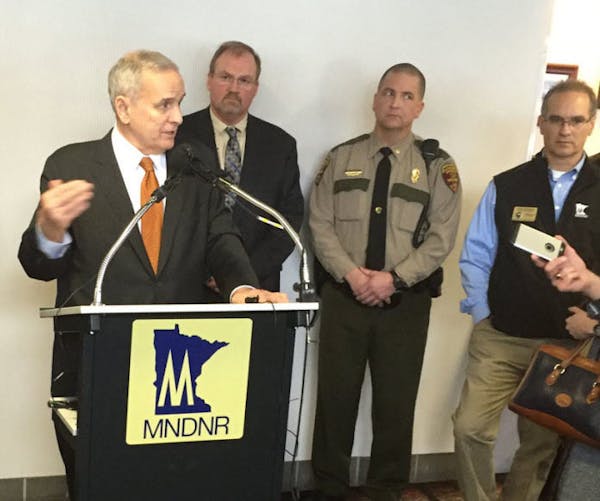Gov. Mark Dayton proposed Friday that the state borrow $1.4 billion to pay for more than 100 public projects around the state, arguing that an overflowing state treasury and low interest rates make it a good time to invest in unmet needs and create construction jobs.
"This is a tremendous opportunity to make the kind of significant investment in the future of Minnesota — in our infrastructure, in our higher education buildings — that we need, and that we are seriously behind in accomplishing," Dayton said.
Several leading Republican legislators immediately labeled it too pricey.
"Gov. Dayton's historically large borrowing proposal should be cut in half," said Senate Minority Leader David Hann, R-Eden Prairie.
The DFL governor's bonding request to the Legislature includes $343 million for construction at public college campuses. He wants $32 million to renovate the 10th Avenue Bridge in Minneapolis and another $42 million to replace the Kellogg Boulevard Bridge over I-94 in St. Paul.
Dayton also proposed $70 million to renovate and add on to the Minnesota Security Hospital in St. Peter, $26 million to improve housing and treatment facilities in the state's legally imperiled sex offender treatment program, $34 million for a new visitor center at Fort Snelling in time for its 2020 bicentennial, and millions more for affordable housing, state prisons, economic development initiatives and other projects around the state.
A day earlier, Dayton laid out in more detail one of his bonding proposal's centerpieces: $220 million to improve water quality in the state, with $167 million to help cities update water treatment systems and $53 million for water protection measures.
Citing an academic study, the Dayton administration said fully enacting his bonding proposal would generate 39,000 jobs around the state, mostly in construction. Anticipating the kind of regional political jockeying that inevitably accompanies a bonding bill, Dayton's team noted that 35 percent of the projects are in the Twin Cities, 35 percent are in the rest of Minnesota and 30 percent are projects of statewide impact.
Leveraging Minnesota's debt capacity is a well-established route for the state's elected leaders to bankroll public construction projects that are too expensive to fund out of the general treasury. Commissioner Myron Frans of Minnesota Management and Budget said that Minnesota's state agencies and its college and university campuses together contain more than 72 million square feet of publicly owned facilities. Dayton's proposal, if fully enacted, would fulfill 37 percent of the total bonding requests currently lodged with the state — about $3.7 billion in all.
State legislators return to St. Paul for a session that starts March 8. Hefty bonding bills are generally reserved for even years, giving most legislators a hometown project or two to tout on the campaign trail a few months later.
Bonding bills are unique in requiring a three-fifths supermajority vote of the House and Senate, requiring bipartisan cooperation that is rare on high-profile pieces of legislation.
While DFL legislators praised Dayton's proposal, Republicans said he would have to trim the wish list.
"House Republicans will be certainly looking at a smaller number than what the governor proposed" — almost definitely under $1 billion, said Rep. Paul Torkelson, R-Hanska, chairman of the House Capital Investment Committee.
Dayton was critical of legislators who took issue with his proposal under what he called "the guise of fiscal responsibility."
"They're wrong," Dayton said. "They say we ought to run government more like a business. Any business with a strong balance sheet, like we have now, that would mean you increase your capital investments."
Torkelson said he wanted to see more road and bridge projects on Dayton's lists. He noted that two of the biggest individual recipients of transportation money — the Minneapolis and St. Paul bridge projects — seemed to leave little money left to address many miles of aging roads and dozens of deteriorating bridges in outstate Minnesota.
Dayton said that was intentional, because he thinks more road and bridge funding should be part of a separate transportation funding bill, expected to be another big debate in the upcoming session. "It will be included in my negotiations with the Legislature," Dayton said.
Notably missing from Dayton's proposal was any bonding money for the state's share of the $1.8 billion Southwest light-rail project or the $1.5 billion line to the northwest metro that's already in planning stages.
"If we're going to fund light rail, it's going to have to be through some metrowide sales tax increase — a quarter percent, half a percent," Dayton said. "Compared to the size of the other needs, it's just not going to be fundable through bonding installments."
Dayton said the state's $1.9 billion budget surplus makes it a good time to lean more heavily on debt capacity. But Sen. Dave Senjem, the lead Republican on the Senate Capital Investment Committee, said legislators also should consider using some of that surplus directly on public infrastructure.
"We ought to be looking at paying cash for some of these things," said Senjem, of Rochester. "We have that opportunity right now. It's not often that we do. Why not look at some cash payments now rather than paying over 20 years and ending up paying almost double given the interest?"
Dayton said he was willing to consider it.
A full list of bonding projects in Dayton's proposal can be found here.
Patrick Condon • 651-925-5049
